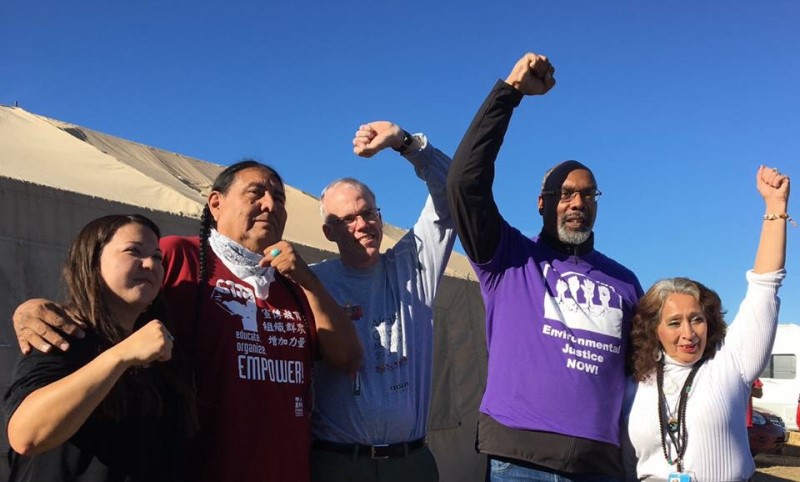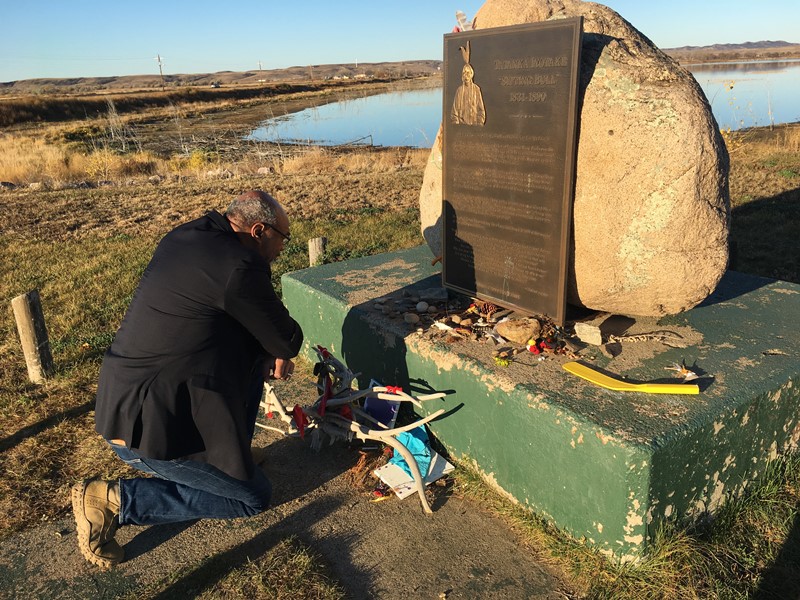
Aaron Mair with (left to right) unidentified activist; Tom Goldtooth, director of the Indigenous Environmental Network; Bill McKibben, co-founder of 350.org; and Ladonna Bravebull Allard, founder of Camp Sacred Stone.
Last week I spent two days on the Standing Rock Sioux reservation in North Dakota, where I met with Native American activists and witnessed once again a frontline nation and people of color bearing the negative brunt of the raw power wielded by the fossil fuel industry—an industry newly emboldened by the election of Donald Trump to the presidency.
I traveled to North Dakota with Mark Westlund, the Sierra Club’s deputy communications director, to demonstrate the Club’s solidarity not only with the Standing Rock Sioux in their fight to stop construction of the Dakota Access Pipeline through sacred tribal lands, but with all communities victimized by environmental injustice.
The Standing Rock Prayer Camp is a reminder of the power of humanity to affect change when we realize that our fates are tied together in this fast-paced battle against the agents of Big Oil and the looming climate crisis. Native American activists and leaders have collaborated to pool their resources and build a model community of resistance. They have moved their families to the front lines and are building schools and other infrastructure to survive the coming North Dakota winter. Activists from Tennessee traveled to Standing Rock with a mobile water filtration system to supply the camp with water so that the waste stream will be relatively free of plastic water bottles. Food, clothing, and other resources are being provided by generous donations, although more will be needed. The Standing Rock Prayer Camp is a harbinger of what will be needed to resist the threats of the carbon industry.
The Prayer Camp is located along the banks of the Cannonball River. Positioned on the high ground overlooking the camp were armed guards, police, and heavy ARV tank trucks that have been transferred to local police under the authority of the National Defense Authorization Act of 1997. Strategy sessions and prayer meetings were carried out under the watchful eyes of police stationed on the rim and the ever-present low-flying planes circling the camp.
The pipeline security and increased police presence was matched by the influx of prayer warriors and interfaith denominations of church leaders from around the country. When prayer and peaceful non-violent resistance against the power of the oil and gas industry in defense of Sioux treaty lands is considered a “violent” act, then all of us, in our nation of laws, need to be concerned.
A Sierra Club delegation including myself, Westlund, Dirty Fuelscampaign director Lena Moffitt, and Environmental Law Program attorney Doug Hayes met with Indigenous Environmental Network director Tom Goldtooth (winner of the Sierra Club's 2016 John Muir Award) and several indigenous leaders to see what additional technical, legal, and grassroots support would be of strategic use for the resistance effort at the Prayer Camp. At the conclusion of our meetings we spoke with a gathering of environmental leaders and lifted our fists, reinforcing our solidarity and commitment to peacefully resist against the “Black Snake," as the Dakota Access Pipeline is known in the Prayer Camp.
Later we met with Standing Rock Sioux tribal chairman Dave Archambault at Standing Rock Sioux tribal headquarters, which occupies a dramatic waterfront location on a peninsula jutting into the Missouri River. He was concluding an intense session with the Army Corps of Engineers over the treaty violations that rerouted the Dakota Access pipeline through Sioux lands in order to protect the City of Bismarck’s water supply. I also presented Chairman Archembault with the traditional offering of a blanket and thanked him for his people’s leadership in the fight against dirty fuels and for allowing the Sierra Club and other environmental leaders to assist in their efforts. I presented him with our Club banner, which brought a smile to his face. He said it had been a long day day and that “this gift has lifted my spirits.”
At the close of that meeting, I publicly reminded Army Corps of Engineers Colonel John Henderson that the tribe's rights were long-standing and that they had a greater right to protection than those possessed by the City of Bismarck. I also emphasized to him how imperative it was that the Water Protectors remain safe and that sacred grounds are not disturbed.
The next afternoon we visited the grave of Sitting Bull, just a few blocks away from the tribal headquarters. The legendary Lakota chief who defeated the forces of George Armstrong Custer at the Battle of Little Bighorn was killed right here on the Standing Rock reservation by Indian agency police in 1890. Given that Sitting Bull is arguably the most famous Native American in history—or at least the version of history we non-Natives are familiar with—Westlund and I were struck by the fact that his grave is so humble -- almost neglectful of the legacy that he left.

The most powerful legacy of this legend was the “Ghost Dance” (Nanissáanah), a religious and spiritual resistance of prayer and dance practiced by the Sioux Nation in 1890 to enlist the spirits of the dead to fight on their behalf, make the white colonists leave, and bring peace, prosperity, and unity to Native peoples throughout the region. Alarmed by the Ghost Dance, the United States government and local authorities sent in thousands of troops to violently put down this peaceful protest and sought the arrest Sitting Bull, who was believed to be one of the spiritual resistance leaders. The unarmed Sitting Bull was shot and killed when the attempt was made to arrest him.
Sound familiar? Fast forward 126 years and the Sioux are again using prayer and peaceful resistance under the global cry of “Mni Wiconi” (Water Is Life) in their fight against dirty fuels and the threat to their lands and water posed by the Dakota Access Pipeline. This time, they have the solidarity of all of the world’s First Nation’s peoples (whose tribal banners ring the Prayer Camp), as well as civil rights and environmental groups, faith communities, justice organizations, students, and concerned individuals. Now, as then, the fear of peace and prayer has elicited a response of dogs, guns, and armored vehicles. Now, as then, the people have come together to camp, resist, and pray for wisdom, deliverance, and justice. The Standing Rock Prayer Camp captures the spirit and the essence of Sitting Bull's prayers for the salvation of his people. Now we are doing a Ghost Dance to save our Mother Earth from the ravages of mankind's addiction to dirty fuels.